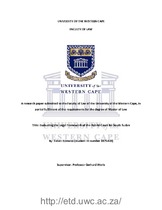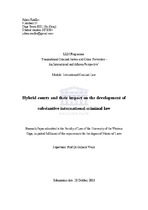| dc.contributor.advisor | Gerhard, Werle | |
| dc.contributor.author | Romano, Taban | |
| dc.date.accessioned | 2020-02-12T12:26:34Z | |
| dc.date.available | 2020-02-12T12:26:34Z | |
| dc.date.issued | 2019 | |
| dc.identifier.uri | http://hdl.handle.net/11394/7101 | |
| dc.description | Magister Legum - LLM | en_US |
| dc.description.abstract | The Republic of South Sudan became independent from the Republic of Sudan on 9 July 2011.
South Sudan has an area of 644, 329 km2 and a total estimated population of around 12, 6
million.1The original state of Sudan was intensely divided along ethnic, religious and ideological
lines. The general population of the Republic of Sudan is mainly Sunni Muslim whereas the
South Sudanese are mostly Christian, with small populations that still practice African
indigenous religions.2While the Republic of Sudan is predominantly Arabic-speaking, English
and over sixty local languages are spoken in South Sudan.3 | en_US |
| dc.language.iso | en | en_US |
| dc.publisher | University of the Western Cape | en_US |
| dc.subject | African Union | en_US |
| dc.subject | Agreement on the Resolution of the Conflict in the Republic of South Sudan | en_US |
| dc.subject | Hybrid Courts | en_US |
| dc.subject | International Criminal Court | en_US |
| dc.subject | International Court of Justice | en_US |
| dc.subject | Legal framework | en_US |
| dc.subject | Legitimacy | en_US |
| dc.subject | Special Court for Sierra Leone | en_US |
| dc.subject | International crimes | en_US |
| dc.subject | Individual criminal responsibility | en_US |
| dc.title | Evaluating the legal framework of the hybrid court for South Sudan | en_US |
| dc.rights.holder | University of the Western Cape | en_US |




